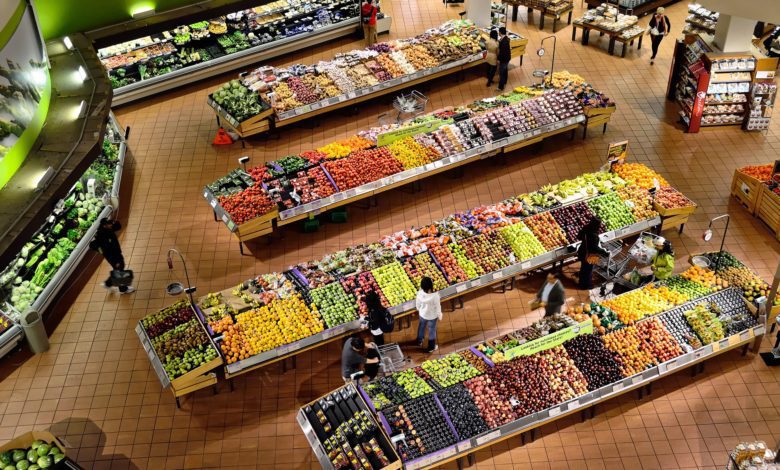Which supermarkets performed the best over Christmas?
Retail Sector looks at how the traditional big four supermarkets performed over Christmas compared to budget retailers like Aldi and Lidl and less traditional supermarkets like M&S

Register to get 1 free article
Reveal the article below by registering for our email newsletter.
Want unlimited access? View Plans
Already have an account? Sign in
According to data from Kantar, Britons made 488 million trips to the supermarkets over the Christmas period, marked out as the four weeks ended 24 December. That number is 12 million more than last year and the largest Christmas period since 2019.
This was mildly surprising in a year that was headlined by the cost of living crisis, bringing with it grocery price inflation pushing prices and other cost pressures elsewhere such as energy price increases really putting the squeeze on consumer spending.
Predictably this was good for budget supermarkets like Aldi and Lidl. In June Kantar found that Aldi had replaced Morrisons as the third biggest supermarket in the country and opened its 1000th store as part of a huge expansion drive.
Not to be left out, Lidl also saw lots of success in 2023, becoming the third biggest supermarket in London and increasing its revenues past £9bn. The company did still post a loss for the full year so it was not quite as successful as its German counterpart Aldi.
And yet, when the golden quarter came and Christmas was upon us shoppers turned to the tried and tested. The traditional big four, Tesco, Sainsbury’s, Asda, Morrisons, plus Waitrose accounted for a combined market share of 70% during the 12 weeks to 24 December according to Kantar.
As Fraser McKevitt, head of retail and consumer insight at Kantar, put it: “The traditional retailers always tend to do well in the run up to Christmas and this year was no exception. Supermarkets saw especially strong performances for their own-label lines, with sales of premium ranges like Sainsbury’s Taste the Difference and Tesco Finest surging by 11.9% compared with last year to hit £790m – accounting for 5.7% of all grocery sales. Branded sales rose by 6.0% during the same period.”
So how did the budget supermarkets perform, how did the traditional supermarkets compare to this and what other retailers were able to score success over Christmas?
Big two remain kings
What Christmas really showed us is that the big two are hard to topple. While Morrisons and Asda have struggled in recent times following takeovers, Tesco and Sainsbury’s continued to dominate. This is perhaps shown by the fact both Tesco and Sainsbury’s have released their Christmas results while Asda and Morrisons have yet to.
Tesco announced that its sales increased 6.9% for the 19 weeks ended 6 January 2024. As a result the company increased its profit guidance for the full year up to £2.75bn, above its previous guidance range of £2.6bn to £2.7bn.
That guidance dwarfs the between £670m and £700m guidance that Sainsbury’s expects to see at the end of the year. The retailer reiterated this expectation after a Christmas period that saw its retail sales jump 6.5% and its Christmas grocery sales increase 8.6%. These numbers follow a difficult period for the retailer and show strong signs of recovery. This is especially important at a time when Asda and Morrisons are struggling.
It also shows us that around Christmas people were willing to spend a bit more for the special day. As previously mentioned, Sainsbury’s Taste the Difference and Tesco Finest sales increased by 11.9% compared with last year hitting £790m. This figure accounted for 5.7% of all grocery sales in the period.
Shoppers still looking for bargains
While the big two of Tesco and Sainsbury’s dominated, budget retailers Aldi and Lidl still saw record breaking Christmas sales. This is in line with the trend we have seen across the year of Lidl and Aldi making gains on the big four but particularly Morrisons and Asda.
Aldi posted sales over £1.5bn in the four weeks to 24 December, an 8% increase year-on-year, while Lidl sales jumped 12% year-on-year. Furthermore Aldi reported that Friday 22 December was its busiest trading day with over 2.5 million customers visiting its stores.
All this bodes well for the two budget supermarkets for 2024. Christmas is usually a time where consumers spend a bit more to treat themselves so the fact that many did not look down their noses at Aldi and Lidl during the period could mean more success for them in the future. The success that each retailer saw coupled with how both performed over the whole of 2023 will surely have Asda and Morrisons looking over their shoulders in the next year.
The outsiders
It was not only traditional supermarkets and budget supermarkets that saw success across Christmas. M&S was the top performing grocer in volume growth terms over the Christmas period and the quarter, as food sales rose 10.5%, with like-for-like sales up 9.9%. This success reinforces the point that consumers were willing to pay a little bit more for something nice as a treat over Christmas despite the economic situation.
As Robyn Duffy, senior analyst at RSM UK, put it :”M&S’s strong results in the food arm of the business support the notion that Christmas 2023 was all about time spent at home with friends and family for consumers. 2022’s acquisition of Gist, a deal geared to improve the food supply chain network of the business, has enabled M&S to be more competitive on pricing, a timely strategy considering food inflation is still over 9%.”
However, it remains to be seen whether this positive momentum will continue into January when many consumers will be feeling the squeeze again and will not have any big occasions to treat themselves on.







